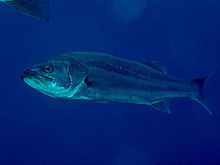
Lateolabrax maculatus

The Japanese seabass, also suzuki (鱸) (Lateolabrax japonicus), is a species of Asian seabass native to the western Pacific Ocean, where it occurs from Japan to the South China Sea. They inhabit fresh, brackish, and marine waters of inshore rocky reefs and in estuaries at depths of at least 5 m (16 ft). This species is catadromous, with the young ascending rivers and then returning to the sea to breed. Its tail is slightly forked and the mouth is large with the lower jaw projecting beyond the upper. Young fish have small black spots on the back and dorsal fin. These spots tend to disappear as fish grows larger. This species can reach a length of 102 cm (40 in), though most do not exceed 16.1 cm (6.3 in). The greatest weight recorded for this species is 8.7 kg (19 lb). This species is important commercially, popular as a game fish, and farmed. Japanese seabass have shiny white flesh with an easily recognizable, broad-flaked structure and a mild flavor. They have traditionally been one of the most popular targets for Japanese anglers. In the Kantō region, including Shizuoka Prefecture, it is called seigo when under 25 cm. At three years of age, when it has attained a length of near 60 cm, it is called fukko or suzuki. Because their name changes as they grow – in Japanese such fish are called shusseuo (出世魚) – the Japanese have associated them with advancement in life and believe Japanese seabass symbolizes good fortune. Like hirame, suzuki makes an elegant paper-thin sashimi, suzuki usu zukuri. Suzuki sashimi is often served with ponzu, a citrus-flavored mild soy sauce, or served in the summertime on a bed of ice cubes with tangy perilla leaf and a scattering of red pepper flakes. Lateolabrax japonicus, more commonly known as 'Japanese Sea Bass', is a species that falls under the genus of lateolabrax. The genus also includes the sister species of L. maculatus, which along with L. japonicus was used to determine the history of the genus and the specific species. Compared to L. maculatus, which is found along the Chinese coast all the way to North Korea, the Japanese sea bass is more geographically restricted, as its habit ranges from Japan to the Southern coast of Korea. The species can both be found in some coastal areas of South Korea. Related to the genus, almost all Lateolabrax species are found in rocky reefs with constant moving waters. However, it is not rare for either species to be found in freshwater as the young tend to enter rivers L.japonicus is also widely farmed in China, since it is a carnivorous species that has delicious meat and grows rapidly. Lateolabrax japonicus is characterized by many black dots on the lateral body region. Its tail is slightly split and the mouth is large with a lower jaw length of 46.43mm and an upper jaw length of 42.36mm. Its body has 12 to 15 spines in the first dorsal followed by 12 to 14 soft rays in its second dorsal. The anal fin has 3 spines and 7 to 9 soft rays. Its common length is 121.69 mm and its weight is 8.7Kg. Japanese seabass larvae commence feeding at day 4 after hatching. The diet of the early larvae is exclusively on smaller zooplankton such as cyclopoids and copepods. Copepods are the most dominant component in the diet of larval JSB, contributing 69.4%. Once this species reaches the juvenile stage, its diet includes sardines, anchovies, and shrimp, as well as any other small fishes and crustaceous. The spawning of this species occurs in the coastal waters around Japan, specifically in the shelf areas with a depth of <100m during late October to late January. Generally, Lateolabrax japonicus eggs are distributed between bay water and outer water because thermohaline regions are formed. However, once their eggs have developed, they are shifted from the surface layer to the middle layer of water. The water temperature where the eggs are placed in a significant factor for the survival rate since their eggs do not tolerate temperatures below 10 °C. The eggs of this species are pelagic, spherical, colorless, and measure about 1.34mm to 1.44mm in diameter with a single oil globule. The transformation from the larva to the juvenile stage is around 49 to 70 days of age and juvenile stage begins at 60 days of age.
